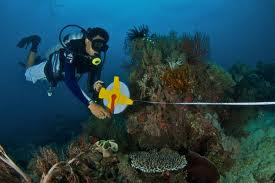Plankton is the foundation of the ocean food web. The word plankton comes from the Greek word "planktos" which means drifting. defined “as organisms that live in the water column whose powers of locomotion are such that they are incapable of making their way against the current and are thus passively transported by currents in the sea". Although some of them have locomotory organs such as cilia and flagella or are able to swim, their movements in the water column are nearly completely controlled by water turbulence and currents and by the bulk density of the organisms.
a) Epilithic phytoplankton:
The percentage abundance of zooplankton found in Pulau Kapas is Bacillariophyceae with 68.20% while the least percentage found is Coscinodiscophyceae with 1.31%. The highest density of zooplankton is Bacillariophyceae with 350000 individual/m3. And, class Coscinodiscophyceae is the least density of zooplankton found in Pulau Kapas. The highest percentage of abundance and density in the class Bacillariophyceae is because of Bacillariophyceae is under a diatom. Diatom is one of the biggest groups in phytoplankton. According to (Shamsudin, 1990) diatom itself contribute 20-25% of primer producer in this earth. Diatoms have relatively simple life cycles that nevertheless show adaptations for survival and dispersal in these fluctuating environments (Steidinger and Walker, 1988). Besides, the reproduction of diatom also was faster compared to other species. They divide by binary fission from normal size frustules until the critical small size frustules. The smaller frustules will then undergo sexual reproduction by fertilisation of egg by sperm cell to form auxospore.
In the phytoplankton 63 µm mesh size, the highest percentage abundance found is from the class Bacillariophyceae with 90.21% while the least percentage abundance of phytoplankton found is Peridinea with 1.05%. On the other hand, the highest density of phytoplankton is class Bacillariophyceae with 302869.57 individual/m3. Bacillariophyceae was also the highest in this mesh size same with the epilithic phytoplankton. It is the same with the epilithic phytoplankton which the dominant class that was recorded is Bacillariophyceae. Bacillariophyceae is a diatom. Diatom has its own way of reproduction. It divides their frustules from normal size to critical small size. Then, the small size frustules will then undergo sexual reproduction by fertilisation of egg by sperm to form auxospore.
120
While in the phytoplankton 120 µm mesh size, the highest percentage of phytoplankton found comes from the class Mediophyceae with 84.94% and the least percentage abundance of phytoplankton found are Coscinodiscophyceae and Dinophyceae with same percentage abundance which is 0.32%. Mediophyceae has a worldwide distribution in boreal to tropical coastal and estuarine environments, apparently absent only from polar oceans. Besides, as the size of the Mediophyceae is less or about 120 µm so it can fix the 120 µm mesh size.
Zooplankton:
In the 63 µm mesh size zooplankton, the highest zooplankton recorded is nauplius with 52.48% while the least percentage abundance of zooplankton found is it includes four classes which is Monogononta, Spirotrechea, Ophilopluteus and others with the percentage abundance 0.25%. The highest density of zooplankton found in the mesh size 63 µm is nauplius with 1000 individual/m3.
120
The highest percentage abundance of zooplankton in 120 µm is class Maxillopoda with 55.48% and the least percentage abundance found is zoea with only 0.33%. The highest density of zooplankton found is class Maxillopoda with 1400 individual/m3. Maxillopods are generally small animals with barnacles being the exception to this rule. Maxillopoda (copepods) have two swimming speeds. The first is slow, steady, and accomplished using their mouthparts. The second looks like a succession of jumps separated by stillness. This jumpy form of swimming in accomplished by the appendages on the thorax. Planktonic copepods have been shown to collect and handle particles in a most interesting way (Koehl and Stickler, 1981) necessary because of their small size and interaction with the water they live in.



















